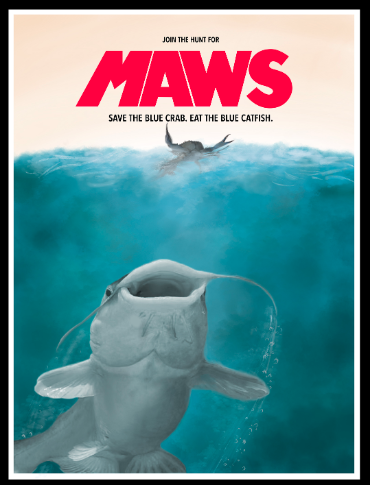The Chesapeake Bay has a long history of challenges to its health and sustainability.
Its ability to not only survive, but also to thrive are threatened by:
- Regular discharges of untreated wastewater from malfunctioning wastewater treatment plants in Baltimore.
- Runoff from farms, streets, parking lots, and development.
- Sediment discharges from Susquehanna River overflows at the Conowingo Dam.
- Constantly fluctuating levels of native species.
If history is any indication, the prospects of meaningful action on any of these challenges is not promising.
There is one constant on all of these challenges. When all is said and done about them, a lot has been said, but almost nothing has been done.
Another serious challenge that has not received widespread attention has been the steadily increasing numbers of blue catfish in the Bay.
Blue catfish are not a new challenge.
They first appeared in the Bay over 50 years ago after they were originally introduced into rivers on Virginia’s western shore.
All expectations were they would remain in those rivers since conventional thinking was blue catfish prefer a freshwater environment.
Defying expectations, blue catfish adapted to higher salinity levels more than anticipated. As a result, they successfully migrated into the Bay where their numbers continue to expand.
They were then and continue to be classified as an invasive species. Their numbers are not only increasing in the Bay, but they are also in every major river in Maryland.
Worse yet, they have no natural predators and are voracious predators of other native species such as blue crabs, clams, mussels, oysters, striped bass (rockfish), menhaden, American eel and other economically and ecologically important species.
Their appetites are so voracious they have been known to devour small blue catfish.
Scientists who follow the Bay ecosystem have concluded that completely eradicating blue catfish in the Bay is not realistic.
Instead, the goal is reducing their numbers in the Bay to a point where native species can at least coexist with them and not become extinct.
Efforts to reduce the blue catfish numbers have had relatively limited success at best.
Ongoing marketing efforts by Maryland’s Department of Agriculture to promote eating blue catfish to chefs, consumers, restaurants, grocery stores and distributors have not made a dramatic difference in demand.
Apparently, many consumers view blue catfish as foul-tasting muddy water bottom feeders.
In reality, many who have eaten blue catfish, me included, have found them to be not only edible, but also nutritious, healthy and delicious.
Even with greater human consumption of blue catfish, more action is needed.
One way to do that is to significantly increase the overall market for them.
That is the goal of legislation that was introduced in Congress earlier this month, the Mitigation Action and Watermen Support Act, or MAWS Act.
If approved by Congress and by President Trump, the MAWS Act is intended to increase blue catfish harvests for use as dog and cat food.
Achieving that goal could lead to greater harvesting of another invasive fish species in the Bay.
Snakehead fish are comparable to blue catfish in terms of being nutritious, healthy and delicious, despite their unappetizing name and appearance.
Going forward there are encouraging developments on the MAWS Act.
It currently has bipartisan sponsorship with two Republican House members from Virginia — Rob Wittman and Jen Kiggans and two Democratic House members from Maryland — Sarah Elfreth and Steny Hoyer.
Wittman, Kiggans and Elfreth are members of the Subcommittee on Water, Wildlife, and Fisheries of the House Natural Resources Committee.
The MAWS Act also has support from the Pet Food Institute of America, whose members make the vast majority of dog and cat food purchased by an estimated 65.1 million households in America who have dogs as pets and an estimated 46.5 million households in America who have cats as pets.
Hopefully, timely enactment and implementation of the MAWS Act will not only help the Bay with two invasive species but also serve as a catalyst for less talk and more action from elected and appointed national, state and local officials to address all the Chesapeake Bay blues.












(0) comments
Welcome to the discussion.
Log In
Keep it Clean. Please avoid obscene, vulgar, lewd, racist or sexually-oriented language.
PLEASE TURN OFF YOUR CAPS LOCK.
Don't Threaten. Threats of harming another person will not be tolerated.
Be Truthful. Don't knowingly lie about anyone or anything.
Be Nice. No racism, sexism or any sort of -ism that is degrading to another person.
Be Proactive. Use the 'Report' link on each comment to let us know of abusive posts.
Share with Us. We'd love to hear eyewitness accounts, the history behind an article.